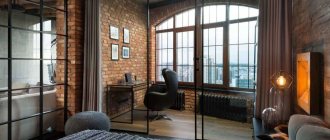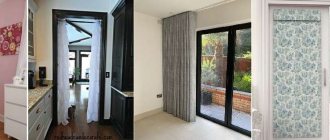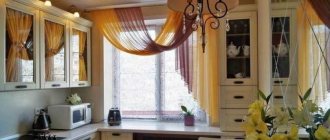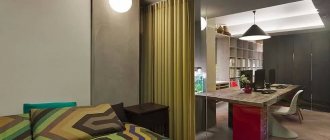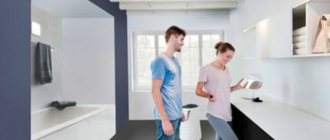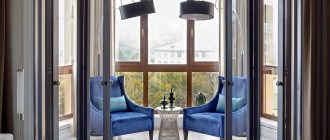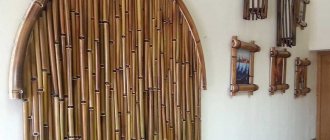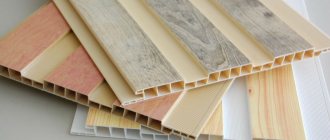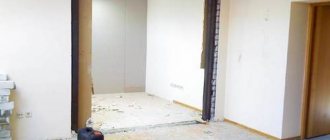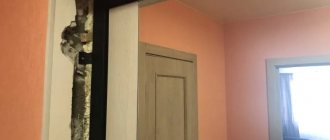The very first curtains on a doorway appeared among people in the Stone Age (and perhaps earlier). It was a skin that covered the entrance to the cave. For some time, the very idea of covering a doorway with fabric or other materials was irrelevant and was considered unnecessary or a relic of the past. This “relic” lasted the longest in villages or in the homes of “creative individuals.” Recently, a trend has emerged again - to decorate the doorway with drapes or curtains. This idea is not without meaning. Even taking into account the functionality of our homes.
How practical is this?
There are two options for using curtains for a door. The first option is that they serve as an addition: the doorway has both a door leaf (or doors) and curtains. Why do you need curtains in this case? For comfort, to make the atmosphere more intimate, to block the light, if the doors are glass, to reduce the penetration of noise. At the entrance to a private house or from the balcony - to reduce the number of insects, so that passersby look into the windows less. There are many more reasons, including “because I want it or like it.”
Doors cannot always be without curtains
The second option is when there are only curtains and no door itself. In this case, it is more a delimitation of space, although all other reasons are also present.
We weigh the pros and cons
As for the practicality of using door curtains, everyone decides for themselves. Here are a couple of notes so you can decide whether this is right for you.
- In families with children, many prefer to have doors because they dampen noise well and do not disturb the child's sleep. On the other hand, dense fabric will further absorb noise. By closing the curtain, you can also cut off the light from another room/corridor. But children love to tug on them or hide in the folds of the fabric. And one more thing: with a child in your arms, getting through doors with curtains is not very convenient, unless they themselves do not block the passage.
In some cases, curtains are simply irreplaceable - For adults, doors are not required. Especially if a person lives alone or is a couple. Only the doors to the bathroom are left in the apartment, the rest of the space is demarcated with curtains of different designs.
- A curtain instead of a door is an excellent solution if there is little space or the door is physically impossible to install. For example, the canvas can perfectly cover a built-in wardrobe - this is a budget replacement for sliding doors.
- Exit to the terrace is often made using glass doors. They are not always completely glass, but, in any case, the glazing area is large. Few people would agree to leave such a door without curtains.
The main advantages of curtains in a doorway are aesthetics, low price, and the ability to quickly replace them. By changing textiles and accessories, it is easy to change not just the color scheme, but even, to some extent, the style of the room.
Choosing a material for sealing a doorway
If you don't plan to use the doorway for storage, you can seal it up. In this case, you will have to decide the question of what material to choose for this purpose.
Consider the following options:
- brick;
- drywall.
Keep in mind that permission must be obtained to completely eliminate the opening.
Brick
Brick has undeniable advantages as the main material for sealing passages. It can be used to brick up openings both in load-bearing external walls and in interior partitions. And there is no particular difference whether these walls are made of reinforced concrete panels or brick. However, we note that it is unlikely that openings in panel houses will be allowed to be moved. But when a room has two entrances, one of them can be abandoned. There are also buildings where there is a section in the load-bearing wall that can be knocked out and thereby form a new portal.
The disadvantage of using brick in aerated block, asbestos-cement or gypsum construction is that the thickness of half the brick does not correspond to the thickness of the wall. Therefore, differences are formed that have to be corrected with plaster. This creates certain problems. You can also try laying the brick on its edge, which is important for thin partitions up to 8 cm. The difference with this method will be only 1 cm.
This difference can be easily removed by increasing the thickness of the plaster layer. If the wall thickness is 9-19 cm, you need to take a one-and-a-half brick with a height of 80 cm and, similarly to the previous option, lay it on its edge. In this case, the thickness of the patch should be less than the thickness of the main structure. The main thing is that the masonry does not protrude beyond the plane of the surface. This will significantly reduce the consumption of plaster mixture.
Before you start laying the passage with piece masonry material, you need to start preparing the base and end surfaces. There should be no threshold or remnants of flooring below. Ideally, the base should be a concrete slab, which should be covered with one layer of roofing felt.
It is necessary to make notches on the new masonry. This will allow it to better adhere to the old one. When sealing a brick wall, you should remove some of the old mortar from the ends, or better yet, slightly knock down the corners of the bricks to form grooves. After this, the surface must be thoroughly dusted and moistened with water or primed. Only after this is it possible to begin sealing the hole.
The laying is done in a standard way with tying the seams. Sometimes long nails are driven into the gaps of the old masonry to drive their free edge into the new one. But this is optional. To fasten the elements, a cement solution is used.
Some craftsmen make recesses in the old masonry in order to insert newly laid bricks into them. Thanks to this, a stable connection is formed between the wall and the new formation. Each subsequent row of bricks must be shifted relative to the previously laid one.
In this case, the strength of the constructed structure will be ensured. The thickness of the solution is carefully adjusted - it should be within 12-14 mm.
After the second or third row, the evenness of the masonry is checked using a building level. You need to make sure there are no distortions. Having sealed the wall with brick, you can rest assured of the excellent soundproofing properties of the “patch”.
Drywall
Alternatively, you can use drywall to seal the walls. It is used when the strength and soundproofing qualities of the structure are not of great importance. With the help of this material, work on sealing the opening can be done in the shortest possible time. In this case, you do not need to have any special professional skills. An undeniable advantage is the affordable cost of the material.
When sealing the passage with plasterboard, you will need to build a frame from a metal profile. Four guides 3-4 m long will be enough. The profile is mounted around the entire perimeter inside the opening in two parallel rows. Fastening to the wall is carried out using dowel-nails 6x40 mm. The products are connected to each other using self-tapping screws equipped with a press washer.
It is necessary to remove the surfaces of the laid area. The guides must be installed at a distance of 12.5 mm from the edge. This distance should take into account the thickness of the gypsum board sheet. Then you need to install crossbars from profile scraps at a distance of 60 mm. You will get a frame to which sheets of drywall will be attached. The gaps can be filled with insulation, which will provide the required level of sound insulation.
It is more correct to use whole sheets of dry plaster, but if desired, you can get by with separate fragments. But do not forget that they need to be joined only at the locations of the crossbars.
To form high-quality joints, an edge plane is needed. With its help, the chamfer can be removed at an angle. Such joints are the easiest to seal properly.
In order to cut solid fragments from plasterboard, you will need a knife with a reinforced blade. Before cutting the material, markings must be applied to its top layer. Next, the leaf shell is cut along this line. After this, the slab is broken, after which all that remains is to cut the cardboard layer from the back side.
The next step is to apply the drywall to the frame and screw it with self-tapping screws at intervals of 20-25 cm. The screws must be screwed in without excessive force so as not to damage the shell of the material. Next, the seams between the gypsum board elements are sealed - in case the cladding was not installed from a single piece.
For finishing you will need a primer mixture, putty and fiberglass reinforcing tape. We treat the seams with a primer, fill them halfway with gypsum mortar and glue the tape, pressing it into the plaster. Next, we putty the sheet over the entire area and leave it for finishing.
Types of curtains in the doorway
In general, curtains are not the only name for fabrics (and not only) that cover a doorway. They also say drapes and curtains. Names in use in different regions mean the same thing. First, let's look at what materials doorway curtains are made of:
- From fabrics. The most common type with many variations.
- Fabric curtains with varying degrees of drapery, with and without lambrequins, with tiebacks on the sides at different heights and hanging freely. Can be hung on any curtain rods.
Along with the usual ones, there are creative ideas for designing doorways - Filament curtains. This is a new product that has a mainly decorative function. This is not fabric, in the full sense of the word, only knitted strips of different thicknesses, more like threads. Hence the name. This also includes wicker macrame curtains.
Thread or beads - decorative only
Japanese curtains. They differ in that it is a straight fabric with a rod inserted into the bottom to avoid wrinkles. Special guides are required along which Japanese curtains can slide without creasing or folding.
There are at least six types of curtains on the doors. In addition, there are still a variety of combinations. Roman blinds can also be hung on the door. They look great in some interiors, but in order to pass through, the door Roman blind must be raised. To do this, you need to pull the chain/rope. And then lower it behind you - again pulling on another rope. How many times will you do this? There is a very high probability that, after some time, it remains raised for a long time. And it will be lowered only if increased privacy is required. Which is also, in principle, not bad.
Advantages
From the examples of photos of curtains on doors, you can see that their purpose and appearance are different.
Door curtains have a number of advantages:
- save from drafts;
- create a barrier against insects entering the room;
- block from the sun;
- serve for zoning space;
- hide from unnecessary eyes;
- allow air to pass through well;
- provide additional sound absorption;
- are combined with a certain idea of room decoration, are part of it;
- serve a decorative role.
How to properly decorate an opening without a door with curtains
Let's talk a little about the selection of fabrics. If the aesthetic side is important to you, everything is clear - you choose from these criteria. If some practical component is required - shading, sound insulation - it is worth approaching the selection of fabric with practical standards.
You can even decorate the entrance doors with curtains
Ordinary fabrics for curtains are often called decorative. They can be smooth, textured, with different types of weave. They can be plain, embossed in the same color or with different patterns.
For darkening, there is another category - denser ones that transmit little light or cut it off almost completely. They are called “darkening” or maybe also called BlackOut. In the characteristics of such fabrics, in addition to the material from which it is made and the density of the weave, the degree of light transmission is indicated. The highest degree is 95-97% dimming. This means that such a curtain will practically exclude light from entering the room.
Select fabrics depending on what functions the curtain on the door will perform
For a greater effect of sound absorption or darkening, or so that the color of the curtains is different from different rooms, double curtains are made (example above in the photo in the center). In this case, the same opening will be decorated with red curtains on one side and beige on the other. Moreover, they do not have to be sewn around the perimeter. Two fabrics can only be sewn/joined at the top.
Curtain fabrics can be patterned
It is not necessary to use plain fabrics for door curtains. They can also have a pattern - floral print or geometry, checkered or striped. Floral curtains fit perfectly into country, shabby chic, and Provence interiors. The fabrics are usually lightweight; in addition to tiebacks, there may also be ruffle gathers.
Main tasks
- An arched curtain in the interior becomes decor and visually delimits the space.
Thread curtains for decorating and delimiting space in the interior
Thread curtains for the arch in red from thin material
The photo shows a modern interior decorated with an arched curtain with internal light decor
- Hiding possible problem areas that arose during the initial construction or when designing an arched doorway.
Decorative curtains for the doorway
If the main function of door curtains is decoration, you can choose any type of curtains. Literally any will do. It is important that they fit into the decor and match in style.
Made from soft flowing fabrics
If the choice falls on fabric curtains, you can choose any fabric that suits the interior. They may be more or less draped. If you want a lot of draperies, the fabric should be soft and flowing.
Curtains in a doorway are most often hung on ordinary tubular curtain rods. You can hang it on one side of the opening (as in the photo below on the right and left) - this is what is done most often. There is another option. It is in the center in the photo - when the cornice is located in the doorway itself - from one edge to the other.
Curtains in the doorway are hung on tubular curtain rods
Notice the photo above on the right. An interesting idea is presented here - two canvases overlap each other. Each of them will cover the doorway in width, but they are hung so that the larger half of one overlaps the other panel. The tiebacks for door curtains must always be “in use”, otherwise you simply won’t be able to get out of the folds. But the drapery looks very interesting.
Pendants made of wood, bamboo
Decorative door curtains include thread curtains and hanging curtains. The latter can be wooden or bamboo, made of beads. There can be a variety of combinations of these materials.
Such curtains have only a decorative function
It is often thought that wooden and bamboo or wooden hangings do not fit into all interiors. It is clear that they look most harmonious in a country-style setting. But they will also be very useful in a modern style. You just need to choose more “technological” options for links and add at least one addition to the interior in the same color. Moreover, this “addition” does not have to be wooden. It is enough that the color is the same. An example in the photo above right.
A curtain instead of a door to the kitchen should be resistant to dirt. And these are definitely not fabrics. Bamboo curtains would be most appropriate here. They are not necessarily brown or have graphic patterns. They can have different designs that are more reminiscent of a painting or graphic object.
Bamboo curtains for the doorway can be patterned
Thread curtains and their options
Thread curtains in a doorway look good and they won’t cost that much. Now they offer a variety of shapes and textures of threads/strands and there are more and more of them every day. Still, this is a more stylish and easier to use alternative to conventional curtains, which are often hung on entrance doors in the summer.
Another type of decorative curtains on the door is thread
We rarely see hanging curtains made of metal links. But they are the ones that best suit modern styles and minimalism. The weight of the links makes them look different, even though they are the lightest alloy. They look different (pictured below).
It would seem, well, what curtains on the door can be in a modern style... But here are examples for you
Even in a technocratic style, an iridescent curtain will look good. By the way, there are similar curtains made of beads. Beads are not necessarily pink or colored. If they are painted with mother-of-pearl, they will fit perfectly into a modern style. And if they are matte and neutral colors, they will look great in a loft.
Features of application
For rooms where the walls are smoothly painted or covered with wallpaper without a bright pattern, you can use curtains with a textured pattern or rich color. They become an element of room decoration.
The choice of textiles is an important stage of decoration
In rooms with bright wallpaper, decorative wall paintings, stretch ceilings with photo prints, use laconic textiles with an unobtrusive pattern or a single color. Thanks to this technique:
- The interior becomes soft and plastic.
- The riot of colors in the decoration is balanced.
- A soft transition between rooms is organized.
Replacing interior doors with fabric, soft decoration is becoming a fashionable trend. This technique is appropriate for living rooms, balconies, loggias combined with the main room, visual separation of functional areas. What are the features of textile use:
- Gives a non-standard decorative effect.
- Helps quickly organize a place for privacy or a sleeping area, separated from the common room.
- Quickly makes the interior beautiful and impressive.
- Does not require large material costs and complex work.
The interior becomes soft and plastic
There are certain restrictions. They need to be taken into account. Textiles absorb dust and dirt and therefore require constant care.
It should not be used in the kitchen as it absorbs odors and soot. The fabric cannot guarantee sound insulation.
Types of door decoration
Designers and decorators create various types of textiles that can decorate a room, emphasize their grandeur, give a decorative effect, and diversify the standard layout:
- Solid sheets of various types of fabric.
- Thread.
- From beads.
- Mosquitoes on magnets.
- Horizontal.
- Vertical.
- Rolled.
- Wooden or bamboo.
The riot of finishing colors is balanced
Material
Let's talk in more detail about the material for decorating doorways. The most common option is fabric. Below we will talk in more detail about different curtain materials that suit different design styles. A wide variety of fabrics and colors gives a huge range of freedom, quickly changes the interior, making it unforgettable.
Advice The fabric used to decorate doorways should be dense, this ensures durability.
Thread options are soft and flexible. Curtains do not guarantee visual isolation, but they do provide decorative variety.
Wooden - made from bamboo or wooden thin bars or sticks. They have a horizontal arrangement of elements, fastening and a lifting mechanism. Roller blinds are used for storage rooms, toilet rooms, dressing rooms. They give the premises a pleasant natural comfort.
A soft transition between rooms is organized
Mosquito net is indispensable for balcony and entrance doors. Functional, convenient design for the entrance area, which has magnetic elements. They quickly connect the two canvases.
Wicker in macrame style is an interesting opportunity to decorate the interior for lovers of handicrafts. You can create a unique model that will make the interior exclusive. A budget option for decorating doors.
Silicone plates are an ideal option for the front door of private houses and cottages. They can withstand large temperature changes and create a thermal curtain between the outside and the inside. The material is durable, waterproof, plastic. Do not think that it is applicable only to industrial premises, car washes and commercial enterprises; it is also applicable to housing.
Textiles can decorate any room
Beads – create radiant splendor. One of the varieties of thread curtains. The final result of decoration depends on the size, color, and texture of the beads. Such curtains are loved by romantic natures; the interior becomes unusual and memorable.
Color
Let us say with complete confidence that there are no restrictions. The entire palette of colors provided by manufacturers of fabric and other materials helps to emphasize the sophistication of the interior, make it memorable, expressive, bring peace or place bright accents.
In decoration, two principles of color selection are used: one that is in harmony with the tone of the wall decoration and one that is contrasting. In the first case, choose an option similar to the main decorating tone. In the second, curtains in bright or rich colors become a stylish highlight for the interior.
Advice Do not split up the space of small apartments with bright textiles with large patterns. They attract attention and make the room look like a small box. But you are unlikely to be comfortable in it.
Helps emphasize sophistication
Fashionable colors: blue, different shades of brown, fuchsia, gray-pink, pearl.
Curtains for an interior arch
Doors are not placed in some openings, but the portal itself remains. It can have sharp corners or rounded at the top. The shape of the opening has little effect on the choice of curtains. It's more about the overall style of the interior. When are curtains needed? If we see two openings of different sizes, heights or shapes (photo below right). In this case, we remove the dissonance.
Curtains are usually used instead of interior doors if privacy for the room is not very important
Zoning is also emphasized with the help of curtains. Modern interiors are increasingly being designed as a single space. In this case, the demarcation makes the room more “homey”. Not everyone likes to live in a “theater” - coziness and adding draperies in the doorway.
Thick curtains between rooms will muffle sounds a little. Curtains, of course, cannot replace doors, but they cannot be compared in terms of installation complexity and price. In addition, doors are not always easy to install. If the door portal starts immediately from the wall, you will struggle with installing the door. This is a general problem with arches - besides the fact that the doors will be made to order at a special price, the installation will also cost a pretty penny.
The whole difficulty is to figure out what the curtains will look like
The photo above shows different types of draperies on arches. What should you consider when choosing the type of drapery? Of course, the height and width of the arched opening. The option on the left - with pompous drapery - is suitable only for very high ceilings. At a standard height, you won’t be able to arrange the folds this way. The option on the right is more suitable for low openings. And the cent is interesting because the opposite folds are sewn. But this is only for those curtains that are stationary and cannot move along the cornice. You shouldn’t do curtains between rooms like this - it’s very impractical - you need to move the fabric back every time. But you can completely cover the entrance to the dressing room.
Features of an interior without doors
A doorway without a door is a popular design technique. This is a practical and fairly inexpensive way to increase usable space and use it more intelligently. By choosing the right finish, you can turn an ordinary opening into a spectacular and unique interior detail.
In what cases would such a method be relevant?
- If necessary, separate the food preparation area from the living room area.
- When zoning large areas.
- When combining adjacent rooms.
We arrange access to a terrace or balcony
As mentioned above, doors to the terrace often have a very large glazing area. Some have only a frame made of wood, metal or plastic, the rest is glass. And not everyone has it mirrored or tinted. In this case, to maintain privacy, the glass must be covered with something. Usually this is one of the types of curtains.
Folds, folds, folds - this is what you often see at the doors to the terrace
Blackout fabrics will come in handy, although this is not necessary. Simply with their help you can make it “almost night” even during a bright day. What are the features? Here, of course, you can organize tiebacks (on racks/beams in the glazing), but more often they simply make free-falling large folds that move to the side. And their height is from floor to ceiling. And no lambrequins or other pomp, unless the style of the room requires it.
As an alternative to folds, you can consider Japanese curtains. There are no coattails here, just a flat canvas.
Japanese curtains on the terrace door: a more modern and stylish option
Japanese curtains require special guides that are attached to the ceiling. The canvases move along these guides. A metal or wooden rod is sewn into the lower part of the panels, which prevents the formation of folds. Here, in fact, is the entire device. These curtains have a more formal look and are suitable for modern, laconic designs.
In what cases can you do without doors?
Not every opening in the house can be stripped of its door leaf. It is difficult to imagine an open passage to a bedroom, office or storage room. However, in this case, you can get by with sliding partitions, screens, curtains, and with their help create an intimate atmosphere. As a result, the visual separation of rooms will be realized and privacy will not be affected.
Door panels are removed if it is necessary to combine:
- kitchen and living room;
- living room and corridor;
- kitchen or living room with loggia;
- bedroom with dressing room.
The rectangular shape of the opening can be preserved and made more interesting through effective finishing. Often apartment owners prefer arched openings of regular and irregular shapes. Asymmetrical variations, round, triangular and trapezoidal portals are in great demand.
Door panels are abandoned if they plan to decorate the passage using stained glass and mosaic modules or a bar counter. Such techniques are especially often used in studio apartments.
As a rule, the decision to abandon doors is associated with the need to redevelop the premises. To create such a design, use:
- expansion of the existing opening;
- creating something new.
An open passage in a load-bearing wall allows you to unify the space while maintaining the rigidity of the building structure.
Cornices for doorways
To decorate a doorway without a door with curtains, use ordinary cornices. There are no special features here. Just select the length of the crossbar and the type of cornice itself. It does not have to be tubular, but these are the ones that are used most often.
The simplest, most popular and inexpensive solution is tubular cornices
It’s more difficult if you want to hang curtains on opening doors, in particular on entrance doors. In this case, the curtain must move with the door or be hung on the side opposite to the direction the door opens. There are several types of similar door cornices. Movable, as in the photo below. One side of them is fixed on the wall next to the door or on the door frame, the second - on the door leaf. When opening and closing, the cornice rotates along with the door.
Movable curtain rods for door curtains are the most functional
For French doors with large glazing, there are short curtain holders. They are mounted directly on the sash above the glass. They are only a few centimeters away from the door leaf. The bad thing is that you can’t make large folds here, only small gathering.
Classic and Magnetic Curtain Holders for French Doors (Large Glass)
In order not to spoil the door leaf, there are magnetic holders for curtains (photo on the right). You glue magnets to the canvas, and the tubular cornice has metal plates. The curtain is small in size, weighs little and holds well thanks to magnets. You can also use a magnetic curtain rod to hang curtains on a glass door. I mean, no frame at all - just glass. Attach the magnets to the glass with glue. Here is the solution to the problem.
Advantages and disadvantages of an opening without a door
A free doorway, not cluttered with doors, has a sophisticated and stylish look. This design is used both in small two- and three-room apartments, and in large-sized cottages and mansions. Let's figure it out - what is the advantage of such a solution?
Pros of not using interior doors:
- Visual expansion of space, which is a significant advantage in small apartments. The absence of a barrier in the form of a door between the dining and kitchen areas, entrance and living room, allows you to move and maneuver faster and more freely.
- This frees up the unused area behind the open door leaf. When the canvas is removed, you can place any piece of decor or furniture in this place. For example, a vase, column, cabinet.
- An area is formed that can be advantageously decorated using a variety of materials. There are plenty of options for decorating the opening.
- Passages decorated in the same style create the feeling of a complete interior ensemble.
- Free air circulation is ensured, which is very important in the heat.
The main disadvantage of unlimited space is the inability to be in a private atmosphere. But this problem is easily solved with the help of a variety of curtains. And if the apartment has a more secluded place - a bedroom or an office, it is better to retire and restore peace of mind in such a closed room.
The following disadvantages can also be identified:
- lack of soundproofing barrier;
- the aromas will spread throughout the house;
- unimpeded penetration of drafts.
Advantages of interior curtains
You can update the decor in a room without radical renovations using textile decoration.
Curtains on the doorway have a number of advantages:
- Decorating a doorway with textiles is easier and cheaper than installing a door block.
- It is problematic to select doors and extensions for a non-standard, complex opening. Curtains are an alternative solution to the problem.
- Curtains “breathe” and allow air to pass through.
- Ideal for arched openings.
Door curtains in walk-through rooms should be equipped with magnetic hooks so as not to move them apart with your hands. The fabric will become less dirty and pass through the opening more conveniently.
How to hang curtains on doors and open passages?
Choose a cornice for the door curtain so that both elements are combined and complement each other. Take into account the general style of the room. The planks come in ceiling and wall mounting types.
- For modern style, it is preferable to use metal cornices with a chrome finish. Blinds are usually attached to such a bar. White cornices match the plastic windows, emphasizing the modern style.
- In a room with a rustic style, they decorate the doorway with a bamboo curtain, and attach it to a wooden cornice or a homemade plank. Wood goes well with straw pendants.
- Thread curtains in an open opening can be hung on a cornice to make them slide to the side. The ropes will not interfere with free passage even if they are securely fixed through the holes on the wooden plank.
Decorating the passage of an interior partition with curtains is most often done independently in order to save money. Although experienced designers also use this technique.
Why should you give up the door?
Before giving life to creative and non-standard ideas, their owner weighs all the pros and cons. Convinced of the correctness of his decision, he begins the process of implementation. Are you still in doubt?
Explore all the advantages of a doorway without doors, and the solution will not keep you waiting long.
- Designing a doorway without a door is much more economical than installing a door leaf.
- Doorways can be of various shapes: in the form of an arch, trapezoid. It is problematic to purchase doors of this shape.
- There is a wide selection of materials for finishing the opening. It can be plastic, wood, glass, forging, drywall (used mainly for shaped openings), textiles. The absence of a door in the opening visually increases the space.
- Expansion of territory is indispensable for practical purposes. When installing doors in openings, you should be very careful about the planned area, because it is important to take into account the fact that the door should open and close freely. And these are all square meters, which, as usual, are not enough.
- Curtains on the door are a hit of modern design. They make the room cozy and comfortable, radically change its external image, transforming and making its entire territory stylish and original. Discover curtains for a doorway, and the small decorative details that make up the curtain will make the room unforgettable for guests, interesting and comfortable for you.
